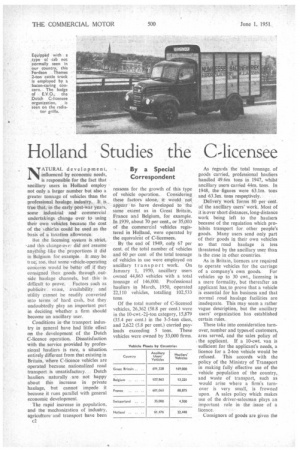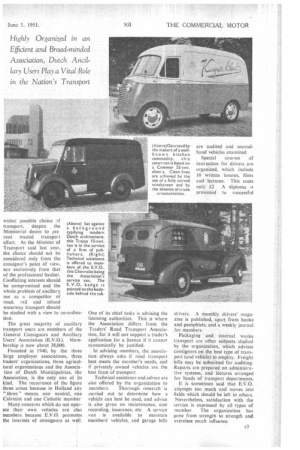Holland Studies the C-licensee
Page 40

Page 41

If you've noticed an error in this article please click here to report it so we can fix it.
By a Special Correspondent NATURAL development, influenced by economic needs, is responsible for the fact that ancillary users in Holland employ not only a larger number but also a greater tonnage of vehicles than the professional haulage industry. It is, true that, in the early post-war years, some industrial and commercial undertakings change over to using their own vehicles because the cost of the ;thicles could be used as the basis of a taxation allowance
But the licensing system is strict, 'and this change-oseF did not assume anything like the proportions it did in Belgium for example. It may be ti tie; too, that some vehicle-operating concerns would be better off if they consigned their goods through outside haulage channels, but this is difficult to prove. Factors such as publicity vaitie, availability, and utility cannot be readily converted into terms of hard cash, but they undoubtedly play an important part in deciding whether a firm should become an ancillary user.
Conditions in the transport industry in general have had little effect on the development of the Dutch C-licence operation. Dissatisfaction with the service provided by professional hauliers is rare, a situation, entirely different from that existing in Britain, where C-licence vehicles are operated because nationalized road transport is unsatisfaetoiy. Dutch hauliers naturally are not happy about this increase in private haulage, hut cannot impede it because it runs parallel with general economic development.
The rapid increase in population, and the mechanization of industry, agriculture and transport have been c2. reasons for the growth of this type of vehicle operation.. Considering these factors alone, it would not appear to have developed to the same extent as in Great Britain, France and Belgium, for example. In 1939, about 70 per cent., or 35,000 of the commercial vehicles registered in Holland, were operated by the equivalent of C-licensees.
By the end of 1949, only 67 per cent, of the total number of vehicles and 60 per cent of the total tonnage of vehicles in use were employed on ancillary transport work. On January 1, 1950, ancillary users owned 44,863 vehicles with a total tonnage of 146,000. Professional hauliers in March, 1950, operated 22,110 vehicles, totalling 102,533 tons.
Of the total number of C-licensed vehicles, 26,362 (58.8 per cent.) were in the 10-cwt.-21-ton category, 15,879 (35.4 per cent.) in the 3-5-ton class, and 2,622 (5.8 per cent.) carried payloads exceeding 5 tons. These vehicles were owned by 33,000 firms.
As regards the total tonnage. of goods carried, professional hauliers handled 49.6m tons in 1947, whilst ancillary users carried 44m. tons. In 1948, the figures were 63.1m, tons and ,63.3m. tons respectively.
• Delivery work forms 80 per cent. Of the ancillary users' work. Most of it is over short distances, long-distance work being left to the hauliers because of the regulation which prohibits transport for other people's goods. Many users send only part of their goods in their own vehicles so that road haulage is less threatened by the ancillary user than is the case in other countries.
As in Britain, licences are required to operate vehicles for the carriage of a company's own goods. For vehicles up to 30 cwt., licensing is a mere formality, but thereafter an applicant has, to prove that a vehicle is essential for his business and that normal road haulage facilities are inadequate. This may seem a rather vague description, but the ancillary users' organization has established certain rules.
These take into consideration turnover, number and types/of customers, area served, and the sales policy of the applicant. If a 10-cwt. van is sufficient for the applicant's needs, a licence for a 2-ton vehicle would be refused. This accords with the policy of the Ministry of Transport in making fully effective use of the vehicle population of the country, and waste of transport, such as would arise where a firm's turnover is very small, is frowned upon. A sales policy which makes use of the driver-salesman plays an important role in the issue of a licence.
Consignors of goods are given the
widest possible choice t-if transport, despite the Ministerial desire to pre vent wasted transpo effort. As the Minister of Transport said last year, the choice should not be considered only from the consignor's point Of view, nor exclusively from that of the professional haulier. Conflicting interests should be compromised and the whole problem of ancillary use as a competitor of road, rail and inland waterway transport should be studied with a view to co-ordination.
The great majority of ancillary transport users are members of the General Consignors and Ancillary Users' Association (E.V.0.). Membership is now about 38,000.
Founded in 1940, by the three large employer associations, three traders' organizations, three agricultural organizations and the Association of Dutch Municipalities, the Association, is the only one of its kind. The recurrence of the figure three arises because in Holland any "three" means one neutral, one Calvinist and one Catholic member
Many concerns which do not operate their own vehicles are also members because E.V.O. promotes the interests of consignors as well.
One of its chief tasks is advising the licensing authorities. This is where the Association differs from the Traders' Road Transport Association, for it will not support a trader's application for a licence if it cannot economically be justified.
In advising members, the association always asks if road transport best meets the member's needs, and if privately owned vehicles are the best form of transport.
Technical assistance and advice are also offered by the organization to members. Thorough research is carried out to determine how a vehicle can best be used, and advice is also given on maintenance, cost recording, insurance, etc. A service van is available to maintain members' vehicles, and garage bills are audited and secondhand vehicles examined
Special courses of instruction for drivers are organized, which include 18 written lessons, films and lectures. This costs only £2 A diploma is presented to successful
drivers. A monthly drivers' magazine is published, apart from books and pamphlets, and a weekly journal for members.
Packaging and internal works transport are other subjects studied by the organization, which advises consignors on the best type of transport (and vehicle) to employ. Freight bills may be submitted for auditing. Reports are prepared on administrative systems, and lectures arranged for heads of transport departments.
It is sometimes said that E.V.O. attempts too much and moves into fields which should be left to others. Nevertheless, satisfaction with the service is expressed by all types of member. The organization has gone from strength to strength and exercises much influence.




























































































